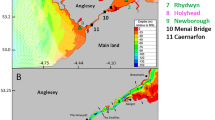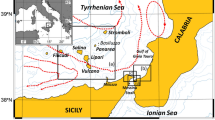Abstract
To predict the larval transport of the Pacific oyster Crassostrea gigas, a particle tracking model using predicted tidal and residual currents has been developed for Matsushima Bay, Japan, a key area for the production of oyster seedlings. We conducted hydrographic observations to obtain three-dimensional distributions of temperature and salinity, which were used as the initial conditions for a residual current model. One-month forecast data for residual currents were calculated, being forced by historically averaged boundary conditions. The observed horizontal distribution of middle-sized larvae was used as the initial larval distribution for the particle tracking model. Prediction calculations of the particle tracking model were conducted for 3 days, during which time middle-sized larvae were assumed to grow to the pre-attachment stage. The predicted larval distribution was validated using the pre-attachment-stage larval distribution observed 3 days after middle-sized larval sampling. The drifting depth and mortality rate of larvae were estimated at 1.75 m and 0.430 day−1, respectively, from case studies related to these parameters. We aim to operate this model routinely and provide predictions of the distribution of pre-attachment stage oyster larvae. This will assist in installing collectors at appropriate times, leading to greater stability in seedling collection.









Similar content being viewed by others
Data availability
The data that support the findings of this study are available from the corresponding author upon reasonable request. The water-level data of the Naruse Rivers are downloaded from the Water Information System (http://www1.river.go.jp/, last accessed 12 May 2022).
References
Botta R, Asche F, Borsum JS, Camp EV (2020) A review of global oyster aquaculture production and consumption. Mar Pol 117:103952. https://doi.org/10.1016/j.marpol.2020.103952
Chen C, Liu H, Beardsley R (2003) An unstructured grid, finite-volume, three-dimensional, primitive equations ocean model: application to coastal ocean and estuaries. J Atmos Ocean Technol 20:159–186. https://doi.org/10.1175/1520-0426(2003)020%3c0159:augfvt%3e2.0.co;2
Chen C, Cowles G, Beardsley RC (2004) An unstructured grid, finite-volume coastal ocean model: FVCOM user manual UMASS-Dartmouth technical report–04–0601. University of Massachusetts, School of Marine Science and Technology, New Bedford, MA, p 183
Epifanio CE, Garvine RW (2001) Larval transport on the Atlantic continental shelf of North America: a review. Estuar Coast Shelf Sci 52:51–77. https://doi.org/10.1006/ecss.2000.0727
Finelli CM, Wethey DS (2003) Behavior of oyster (Crassostrea virginica) larvae in flume boundary layer flows. Mar Biol 143:703–711. https://doi.org/10.1007/s00227-003-1110-z
Fujihara M, Akeda S, Takeuchi T (1992) Development of multi-level density flow model and its application to the upwelling generated by artificial structures technical report of national research institute of fisheries engineering. Aquac Fish Port Eng (Japan) 14:13–35 (in Japanese with English abstract)
Fujiie W, Yanagi T, Tamaki A, Matsuno T (2004) Recruitment strategy of the callianassid shrimp Nihonotrypaea harmandi on Tomioka Tidal Flat, western Kyushu, Japan. Oceanogra Japan 13:371–387 (in Japanese with English abstract)
Fujiya M (1970) Oyster farming in Japan. Helgolander Wissenschaftliche Meeresuntersuchungen 20:464–479
Haase AT, Eggleston DB, Luettich RA, Weaver RJ, Puckett BJ (2012) Estuarine circulation and predicted oyster larval dispersal among a network of reserves. Estuar Coast Shelf Sci 101:33–43. https://doi.org/10.1016/j.ecss.2012.02.011
Hasegawa N, Onitsuka T, Takeyama S, Maekawa K (2015) Oyster culture in Hokkaido, Japan. Bull Fish Res Agen 40:173–177
Kakehi S, Kamiyama T, Abe H, Hanawa S, Oota H, Matsuura R, Oshino A (2016) Mechanisms leading to the decline in Pacific oyster Crassostrea gigas seedlings in Matsushima Bay, Japan. Fish Sci 82:499–508. https://doi.org/10.1007/s12562-016-0982-z
Kakehi S, Shirai H, Magome S, Takagi T, Okabe K, Takayanagi K, Hamaguchi M, Ito H, Kamiyama T (2020) Predicting the larval transport of Pacific oyster Crassostrea gigas during the seedling collection season. Fish Oceanogr 29:484–504. https://doi.org/10.1111/fog.12491
Kakehi S, Sekiuchi T, Ito H, Ueno S, Takeuchi Y, Suzuki K, Togawa M (2021) Identification and counting of Pacific oyster Crassostrea gigas larvae by object detection using deep learning. Aquac Eng 95:102197. https://doi.org/10.1016/j.aquaeng.2021.102197
Kan-no H, Sasaki M, Sakurai Y, Watanabe T, Suzuki K (1965) Studies on the mass mortality of the oyster in Matsushima Bay I. General aspects of the mass mortality of the oyster in Matsushima Bay and its environmental conditions. Bull Tohoku Natl Fish Res Inst 25:1–26 (in Japanese with English abstract)
Kim CK, Park K, Powers SP, Graham WM, Bayha KM (2010) Oyster larval transport in coastal Alabama: dominance of physical transport over biological behavior in a shallow estuary. J Geophys Res: Oceans 115:C10019. https://doi.org/10.1029/2010JC006115
Koganezawa A (1978) Ecological study of the production of seeds of the Pacific oyster, Crassostrea gigas. Bull Jap Sea Reg Fish Res Lab 29:1–88 (in Japanese with English abstract)
Kuroda H, Setou T, Kakehi S, Ito SI, Taneda T, Azumaya T, Inagake D, Hiroe Y, Morinaga K, Okazaki M, Yokota T, Okunishi T, Aoki K, Shimizu Y, Hasegawa D, Watanabe T (2017) Recent advances in Japanese fisheries science in the Kuroshio–Oyashio region through development of the FRA-ROMS Ocean forecast system: overview of the reproducibility of reanalysis products. Open J Mar Sci 7:62–91. https://doi.org/10.4236/ojms.2017.71006
Lagarde F, Fiandrino A, Ubertini M, d’Orbcastel ER, Mortreux S, Chiantella C, Bec B, Bonnet D, Roques C, Bernard I, Richard M, Guyondet T, Pouvreau S, Lett C (2019) Duality of trophic supply and hydrodynamic connectivity drives spatial patterns of Pacific oyster recruitment. Mar Ecol Prog Ser 632:81–100. https://doi.org/10.3354/meps13151
Levin LA (2006) Recent progress in understanding larval dispersal: new directions and digressions. Integ Comp Biol 46:282–297. https://doi.org/10.1093/icb/icj024
Loosanoff VL, Davis HC (1963) Rearing of bivalve mollusks. Adv Mar Biol 1:1–136. https://doi.org/10.1016/S0065-2881(08)60257-6
Ministry of agriculture, forestry and fisheries (2022). Fisheries and aquaculture statistics in 2020. https://www.e-stat.go.jp/stat-search/file-download?statInfId=000032166246&fileKind=0 (in Japanese)
North EW, Schlag Z, Hood RR, Li M, Zhong L, Gross T, Kennedy VS (2008) Vertical swimming behavior influences the dispersal of simulated oyster larvae in a coupled particle-tracking and hydrodynamic model of Chesapeake Bay. Mar Ecol Prog Ser 359:99–115. https://doi.org/10.3354/meps07317
Puckett BJ, Eggleston DB, Kerr PC, Luettich RA (2014) Larval dispersal and population connectivity among a network of marine reserves. Fish Oceanogr 23:342–361. https://doi.org/10.1111/fog.12067
Tanabe T (2013) Impact of the great Eastern Japan earthquake and efforts for restoration on Japanese Oyster Crassostrea gigas farming. Nippon Suisan Gakkaishi 79:721–723 (in Japanese)
Watanabe K, Abe K, Suzuki K, Sato K (1972) Tidal currents through straits in Matsushima Bay. Bull Miyagi Pref Fish Inst 6:1–88 (in Japanese)
Zhang X, Haidvogel D, Munroe D, Powell EN, Klinck J, Mann R, Castruccio FS (2015) Modeling larval connectivity of the Atlantic surfclams within the middle Atlantic Bight: model development, larval dispersal and metapopulation connectivity. Estuar Coast Shelf Sci 153:38–53. https://doi.org/10.1016/j.ecss.2014.11.033
Acknowledgements
We thank Sanyo Techno Marine Inc. for providing mooring observational data. We also thank O. Ito and S. Takeshita, the captains of the chartered boats and K. Yokouchi of Japan Fisheries Research and Education Agency for their help in conducting the observations. We also thank M. Hamaguchi of Japan Fisheries Research and Education Agency for providing specific fluorescently labeled monoclonal antibodies for identifying Pacific oyster larvae and M. Satta of Seibutsu Seitai Kenkyusha, Ltd., for detecting and counting oyster larvae. We thank T. Arao, Y. Kashimura, and T. Watanabe of the National Agriculture and Food Research Organization and M. Hirai of IDEA Consultants, Inc. for their useful comments in conducting this research. This research was supported by the research program on development of innovative technology grants from the Project of the Bio-oriented Technology Research Advancement Institution (BRAIN). We thank Edanz English Editing Services (https://jp.edanz.com/ac) for editing the draft of this manuscript.
Funding
The research program on development of innovative technology grants from the Project of the Bio-oriented Technology Research Advancement Institution (BRAIN), 02001A, Shigeho Kakehi.
Author information
Authors and Affiliations
Contributions
S.K. designed the entire study, developed numerical models, conducted observations, analyzed obtained data, and wrote the manuscript.
Corresponding author
Ethics declarations
Conflict of interest
The author has no conflicts of interest to declare.
Additional information
Publisher’s Note
Springer Nature remains neutral with regard to jurisdictional claims in published maps and institutional affiliations.
Supplementary Information
Below is the link to the electronic supplementary material.
Rights and permissions
Springer Nature or its licensor holds exclusive rights to this article under a publishing agreement with the author(s) or other rightsholder(s); author self-archiving of the accepted manuscript version of this article is solely governed by the terms of such publishing agreement and applicable law.
About this article
Cite this article
Kakehi, S. Developing short-term predictions for the distribution of Pacific oyster Crassostrea gigas larvae. Fish Sci 88, 593–608 (2022). https://doi.org/10.1007/s12562-022-01621-1
Received:
Accepted:
Published:
Issue Date:
DOI: https://doi.org/10.1007/s12562-022-01621-1




